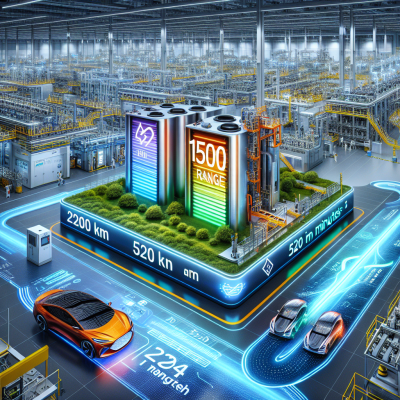
Introduction: CATL Redefines the Future of EV Batteries
Contemporary Amperex Technology Co. Limited (CATL), the world’s largest producer of electric vehicle (EV) batteries, has once again amazed the automotive world with a groundbreaking showcase of three significant innovations. With promises of a 1500km driving range, revolutionary 5-minute ultra-fast charging, and the mass production of sodium-ion batteries starting in 2025, CATL is solidifying its place as a pivotal force in the electrification movement.
Breakthrough #1: 1500km Extended Range Battery
Imagine driving from Beijing to Shanghai on a single charge—this is fast becoming reality thanks to CATL’s newest technological leap. The company unveiled a new battery capable of delivering an astonishing 1500 kilometers (932 miles) of range on a full charge.
How Does It Work?
This revolutionary range is made possible by CATL’s mastery over energy density improvements. Although exact technical specifics were closely guarded during the announcement, CATL credited a synergy of advanced materials, proprietary manufacturing processes, and next-gen battery architecture for achieving this milestone.
Implications for the EV Industry
Benefits that could reshape the entire EV landscape include:
- Range Anxiety Elimination: With 1500km at your disposal, concerns over charging station availability drastically diminish.
- Expansion of EV Adoption: Consumers previously hesitant due to limited ranges may now consider switching to electric vehicles.
- New Vehicle Designs: Automakers might shift focus from battery size to overall performance and efficiency.
Breakthrough #2: 520km Range Added in Just 5 Minutes
Perhaps even more impressive is CATL’s announcement of an ultra-fast charging solution. Now, EVs powered by CATL’s new battery can add 520 kilometers (323 miles) of range in just five minutes.
The Science Behind Lightning-Fast Charging
CATL’s ultra-fast charging technology leverages innovations in:
- Enhanced Thermal Management: Keeping the battery cool during intense charging sessions prevents degradation and maintains safety.
- New Electrolyte Formulations: Custom-designed to support higher current flow without causing damage.
- Redesigned Anode Materials: Better accommodate the rapid influx of energy, reducing charge time exponentially.
Why It Matters
Fast charging capabilities are crucial for mainstream EV adoption. With this advancement:
- Charging Stations Become More Practical: Time spent charging could almost match traditional refueling stops for combustion engines.
- Boost for EV Road Trips: Long journeys become feasible without hours-long charging breaks.
Breakthrough #3: Mass Production of Sodium-Ion Batteries by 2025
CATL also reaffirmed its commitment to diversifying battery technologies by announcing plans for the mass production of sodium-ion batteries in 2025.
Advantages of Sodium-Ion Batteries
- Abundance and Cost: Unlike lithium, sodium is plentiful and inexpensive, bringing down material costs dramatically.
- Environmentally Friendly: Extracting sodium has a lower environmental impact compared to lithium mining.
- Excellent Cold Weather Performance: Sodium-ion batteries have better low-temperature charge and discharge capabilities.
Market Implications
Sodium-ion batteries could primarily be used in:
- Entry-Level EVs: Making electric mobility accessible to broader demographics.
- Grid Storage Solutions: Offering a stable and affordable option for renewable energy storage systems.
CATL’s Vision for the Future
The triple-announcement propels CATL into a new era of innovation. Their multi-pronged approach addresses the key barriers to EV adoption: range, charging time, cost, and sustainability.
Strategic Investments and Partnerships
CATL’s extensive investment in R&D and strategic partnerships with major automakers will ensure that these pioneering technologies reach consumers swiftly. Early adopters are expected to benefit as soon as 2025 when sodium-ion batteries hit mass production lines.
Commitment to Green Technology
Beyond mere innovation, CATL emphasizes environmental stewardship by prioritizing sustainable materials, lower carbon footprints, and lifecycle battery management practices.
Conclusion: A New Chapter for Electric Mobility
CATL’s latest innovations herald a future where EVs are no longer a compromise but a full-fledged alternative to fossil-fueled vehicles. With extended ranges, lightning-quick charging, and cost-friendly sodium-ion options looming on the horizon, the dream of an all-electric future seems closer—and more exciting—than ever before.
Stay tuned, because the electrification race just shifted into high gear!


Leave a Reply